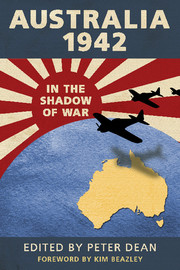Book contents
- Frontmatter
- Foreword
- Contents
- Photos
- Maps
- Charts
- Acknowledgements
- Contributors
- Abbreviations
- Maps
- Introduction
- Part 1 Australia in 1942
- Part 2 Relations, politics and the home front
- Part 3 Australia under threat
- Part 4 The war on Australia’s doorstep
- Chapter 9 Vanquished but defiant, victorious but divided
- Chapter 10 A novel experience
- Chapter 11 On Australia’s doorstep
- Chapter 12 Anzacs and Yanks
- Conclusion
- Index
- References
Chapter 11 - On Australia’s doorstep
Kokoda and Milne Bay
from Part 4 - The war on Australia’s doorstep
Published online by Cambridge University Press: 05 January 2013
- Frontmatter
- Foreword
- Contents
- Photos
- Maps
- Charts
- Acknowledgements
- Contributors
- Abbreviations
- Maps
- Introduction
- Part 1 Australia in 1942
- Part 2 Relations, politics and the home front
- Part 3 Australia under threat
- Part 4 The war on Australia’s doorstep
- Chapter 9 Vanquished but defiant, victorious but divided
- Chapter 10 A novel experience
- Chapter 11 On Australia’s doorstep
- Chapter 12 Anzacs and Yanks
- Conclusion
- Index
- References
Summary
Japan’s attacks on Pearl Harbor, the Philippines, Malaya and elsewhere on 7–8 December 1941 changed Australia’s war. Overnight, the war went from a distant conflict fought against the Germans and Italians in North Africa, the Mediterranean and in the skies above Europe, to a war suddenly being waged on Australia’s doorstep. In a radio broadcast to the nation on 8 December 1941, Prime Minister John Curtin warned the men and women of Australia that the forthcoming Pacific War would be ‘the gravest hour in our history’. ‘This’, he continued, ‘is our darkest hour’. This was not just political rhetoric. Focusing Australia’s military effort and modest resources on the European war had come at the expense of Australia’s home defences that, in December 1941, were in a dire state.
In the weeks and months to come, Australia would rapidly mobilise and industrialise for war. The Navy grew just as the Air Force expanded with new squadrons and modern aircraft. The battle-hardened AIF was recalled from the Middle East and the militia’s ranks swelled with men called up for service. But in early 1942, time was a luxury Australia did not have. The only island barrier that remained between mainland Australia and the Japanese was Papua. Here, along the Kokoda Trail in Papua’s imposing Owen Stanley Range, Australian soldiers fought against a formidable enemy and battled an exhausting terrain. A powerful motivator for the Australian soldiers to enduring these hardships was the belief that they were fighting to stop the Japanese southern advance, with one veteran later likening the campaign to ‘Australia’s Thermopylae’. Australian forces also fought a desperate action at Milne Bay, on Papua’s southeast coast. This chapter will give an overview of these two campaigns.
- Type
- Chapter
- Information
- Australia 1942In the Shadow of War, pp. 199 - 216Publisher: Cambridge University PressPrint publication year: 2012

